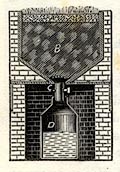




self sees their fallacy, and points out some of their faults; but, though experiments, on a limited scale, have been tried from time to time, the question has never been fairly grappled. Good suggestions have been dropped here and there; and, before anything is actually commenced, all previous experiments - those of Dalton, Charnock, Daniell, Howard, Miller, Buist of Bombay, Golding of Copenhagen, Haughton of St Helena, and others, must be reviewed.


It appears to me that a rather troublesome and costly process is necessary before we can at all presume to decide on any instrument for general use, and that it should take the form of a series of experiments, with compartments of a cubic yard each, sunk in the ground, waterproof, funnel shaped at the bottom, with taps and cans. The simplest mode of carrying it out would probably be to cut a trench about 30 ft. long, and 6 ft. deep, in a spot where perfect drainage could be secured, and then form the cubes in brickwork, lined with Portland cement, leaving a sunk path in front, to give access to the cans, as shown in the section of one. The cubes could be filled with various substances; and by their modification, and at one time leaving the taps (C) open, and another closing them - by leaving them with no water but the rain, and at other times keeping their contents in a state of saturation, we should not only go far beyond anything that has been done before, but should probably be led to some simple form of instrument which, even if not itself correct, might bear a known per-centage of error, and be available for differential results.


Wherever these or similar experiiments are tried, a regular record must be kept of the dry and wet bulb thermometers, and it may also be expedient to try the self-registering hygrometers invented by Mr. Vivian, of Torquay, and exhibited at the Oxford meeting of the British Association.

 British Rainfall 1867, p.10
British Rainfall 1867, p.10